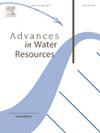Impact of efflorescence on internal salt precipitation dynamics during injection of gases in porous rocks
IF 4
2区 环境科学与生态学
Q1 WATER RESOURCES
引用次数: 0
Abstract
Porous geological formations play an important role as storage media for CO2 and H2. Brine in these formations can evaporate during gas injection, leading to salt precipitation. Estimating how and where salt precipitates is important to understand its influence on injectivity. So far, studies on gas injection scenarios primarily focused on formation dry-out inside the pore space. However, salt precipitation on external rock surfaces exposed to dry-out (e.g., the wellbore interface) can strongly influence drying dynamics as well. The occurrence of salt precipitation on these surfaces and its relation to the internal precipitation dynamics remain unclear. Therefore, we conducted experiments injecting dry gas into Bentheimer sandstone at two flow rates in the advective regime and for two different brine salinities. We tracked precipitation on both the gas injection surface and in the pores via in-situ μCT imaging. Salt precipitation on the surface occurred for all cases, and precipitation within the pores exhibited heterogeneous distribution, with higher salt accumulation at higher salinities and lower flow rates. Porosity decreased by less than 3 % for all cases, nevertheless accompanied by up to 20 % reduction in permeability. Our experiments suggest a strong correlation in time between precipitation dynamics within the pores and on the injection surface. We discovered a sudden decrease in brine concentration inside the pores during dry-out, with a simultaneous increase in the rate of precipitated salt volume on the surface, highlighting a previously unrecognized interaction. This work provides insight into complex drying and precipitation dynamics during gas injection, which carries important implications for well injectivity impairment in field operations.
多孔岩石注气过程中风化对内部盐沉淀动力学的影响
多孔地质构造是CO2和H2的重要储存介质。在注气过程中,这些地层中的盐水会蒸发,导致盐沉淀。估算盐沉淀的方式和位置对于了解其对注入能力的影响非常重要。到目前为止,对注气场景的研究主要集中在孔隙空间内的地层干涸。然而,暴露于干燥的外部岩石表面(例如井筒界面)的盐沉淀也会强烈影响干燥动力学。这些地表盐降水的发生及其与内部降水动力学的关系尚不清楚。因此,我们进行了实验,在平流状态下以两种流速和两种不同的盐水盐度向Bentheimer砂岩注入干气。通过原位μCT成像对注气表面和孔隙中的降水进行了跟踪。表层均有盐沉淀,且孔隙内降水呈非均匀分布,盐度越高,流速越小,积累量越大。在所有情况下,孔隙度降低不到3%,但渗透率降低高达20%。我们的实验表明,孔隙内和注射表面的沉淀动力学在时间上有很强的相关性。我们发现,在干燥过程中,孔隙内的盐水浓度突然下降,同时表面上沉淀盐体积的速率增加,突出了以前未被认识到的相互作用。这项工作提供了对注气过程中复杂的干燥和降水动态的深入了解,这对现场作业中井的注入能力损害具有重要意义。
本文章由计算机程序翻译,如有差异,请以英文原文为准。
求助全文
约1分钟内获得全文
求助全文
来源期刊

Advances in Water Resources
环境科学-水资源
CiteScore
9.40
自引率
6.40%
发文量
171
审稿时长
36 days
期刊介绍:
Advances in Water Resources provides a forum for the presentation of fundamental scientific advances in the understanding of water resources systems. The scope of Advances in Water Resources includes any combination of theoretical, computational, and experimental approaches used to advance fundamental understanding of surface or subsurface water resources systems or the interaction of these systems with the atmosphere, geosphere, biosphere, and human societies. Manuscripts involving case studies that do not attempt to reach broader conclusions, research on engineering design, applied hydraulics, or water quality and treatment, as well as applications of existing knowledge that do not advance fundamental understanding of hydrological processes, are not appropriate for Advances in Water Resources.
Examples of appropriate topical areas that will be considered include the following:
• Surface and subsurface hydrology
• Hydrometeorology
• Environmental fluid dynamics
• Ecohydrology and ecohydrodynamics
• Multiphase transport phenomena in porous media
• Fluid flow and species transport and reaction processes
 求助内容:
求助内容: 应助结果提醒方式:
应助结果提醒方式:


